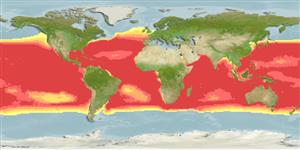Ikan bertulan sejati >
Perciformes (Perch-likes) >
Scombridae (Mackerels, tunas, bonitos) > Scombrinae
Etymology: Thunnus: Greek, thynnos = tunna (Ref. 45335).
Lingkungan / Klimat / Range
Ekologi
; laut; payau; oceanodromus (Ref. 51243); kisaran kedalaman 1 - 250 m (Ref. 6390), usually 1 - 100 m (Ref. 55289). Tropical; 15°C - 31°C (Ref. 168), preferred 28°C (Ref. 107945); 59°N - 48°S, 180°W - 180°E
Worldwide in tropical and subtropical seas, but absent from the Mediterranean Sea. Highly migratory species, Annex I of the 1982 Convention on the Law of the Sea (Ref. 26139).
Length at first maturity / Size / Weight / umur
Maturity: Lm 103.3, range 78 - 158 cm
Max length : 239 cm FL jantan/; (Ref. 40637); common length : 150 cm FL jantan/; (Ref. 168); Berat maksimum terpublikasi: 200.0 kg (Ref. 26550); Umur maksimum dilaporkan: 9 Tahun (Ref. 72462)
Duri punggung (Keseluruhan (total)): 11 - 14; duri punggung lunak (Keseluruhan (total)): 12-16; Duri dubur 0; Sirip dubur lunak: 11 - 16; vertebrata, bertulang belakang: 39. Fish with very long second dorsal fin and anal fin, which in some may reach well over 20% of the FL. The pectoral fin is moderately long, usually reaching beyond the second dorsal fin origin but not beyond the end of its base. Color is black metallic dark blue changing through yellow to silver on the belly. The belly frequently has about 20 broken, nearly vertical lines. The dorsal and anal fins and finlets are bright yellow.
An oceanic species occurring above and below the thermoclines. Pelagic in open water , but rarely seen near reefs (Ref. 48637). They school primarily by size, either in monospecific or multi-species groups. Larger fish frequently school with porpoises, also associated with floating debris and other objects. Feed on fishes, crustaceans and squids. It is sensitive to low concentrations of oxygen and therefore is not usually caught below 250 m in the tropics (Ref. 28952, 30329). Peak spawning occurs during the summer, in batches (Ref. 9684, 51846). Eggs and larvae are pelagic (Ref. 6769). Encircling nets are employed to catch schools near the surface (Ref. 9340). Marketed mainly frozen and canned (Ref. 9684), but also fresh (Ref. 9340) and smoked (Ref. 9987). Highly valued for sashimi (Ref. 26938).
Spawn throughout the tropical and equatorial waters of the major oceans (Ref. 6390). At higher latitudes, spawning is seasonal, with peaks in summer; may continue throughout the year at lower latitudes (Ref. 6390).
Yellowfin tuna are multiple spawners, ie they spawn every few days over the spawning period (Ref. 6390). Eggs and sperm are released into the water for fertilisation (Ref. 6390).
Collette, B.B. and C.E. Nauen, 1983. FAO Species Catalogue. Vol. 2. Scombrids of the world. An annotated and illustrated catalogue of tunas, mackerels, bonitos and related species known to date. Rome: FAO. FAO Fish. Synop. 125(2):137 p. (Ref. 168)
Status IUCN Red List (Ref. 115185)
CITES (Ref. 94142)
Not Evaluated
ancaman kepada manusia
Harmless
penggunaan manusia
Perikanan: bernilai komersial tinggi; Budidaya air: percobaan; Ikan buruan: ya
Alat, peralatan
laporan khas
muat turun XML
Sumber internet
Estimates of some properties based on models
Phylogenetic diversity index (Ref.
82805): PD
50 = 0.5039 [Uniqueness, from 0.5 = low to 2.0 = high].
Bayesian length-weight: a=0.01413 (0.01129 - 0.01767), b=3.03 (2.99 - 3.07), in cm Total Length, based on LWR estimates for this species (Ref.
93245).
Trophic Level (Ref.
69278): 4.4 ±0.4 se; Based on diet studies.
Daya lenting (Ref.
69278): sedang, Waktu penggandaan populasi minimum 1.4 - 4.4 tahun (K=0.13-0.42; tm=2-5; tmax=8; Fec=200,000).
Prior r = 0.6, 2 SD range = 0.27 - 1.34, log(r) = -0.51, SD log(r) = 0.4, Based on: 2 M, 33 K, 4 tgen, 4 tmax, 6 Fec records
keancaman (Ref.
59153): Moderate to high vulnerability (46 of 100) .
